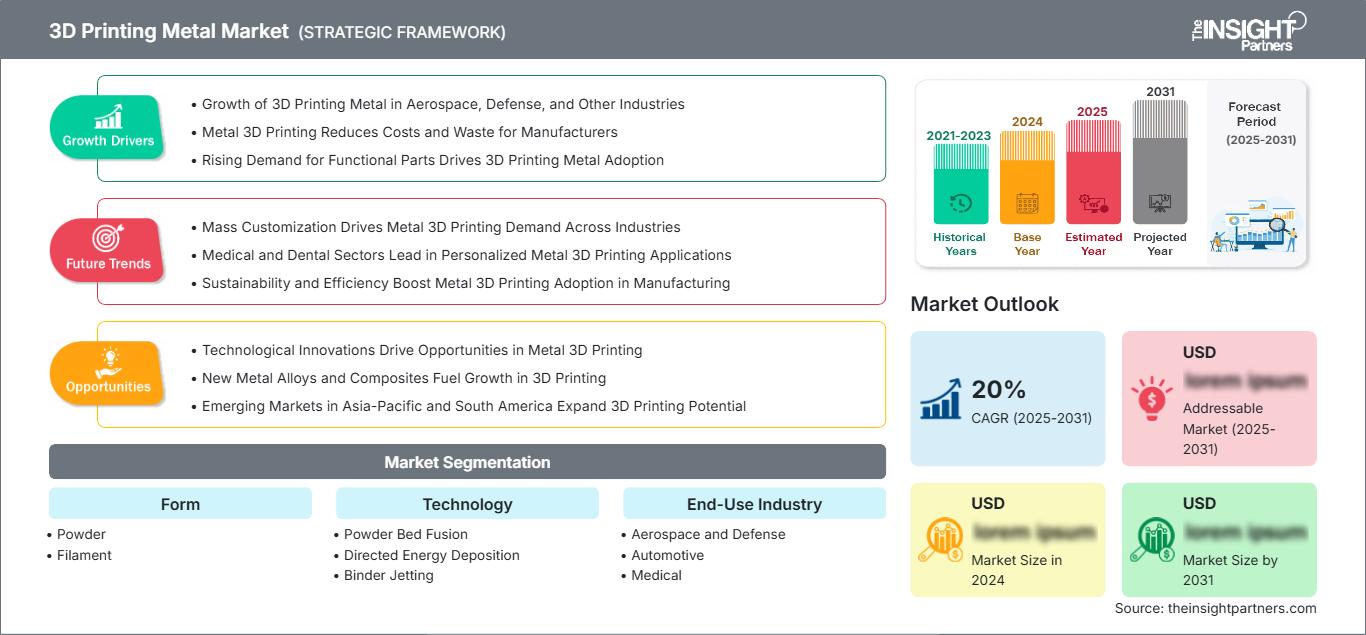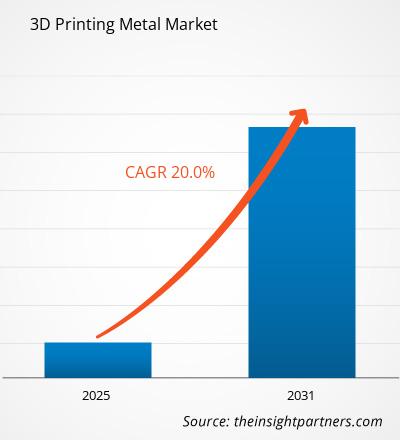3Dプリンティング金属市場調査の規模は、2031年までに32億9000万米ドルに達すると予想されています。市場は2025年から2031年の間に18.4%のCAGRを記録すると予想されています。
3Dプリンティング金属市場レポートは、形態(粉末とフィラメント)別にセグメント化されています。レポートではさらに、技術(粉末床溶融結合法、指向性エネルギー堆積法、バインダージェッティング法、金属押し出し法など)に基づく分析を提示しています。レポートは、金属の種類(チタン、ニッケル、ステンレス鋼、アルミニウムなど)に基づいてセグメント化されています。レポートはまた、最終用途産業(航空宇宙および防衛、自動車、医療など)に基づいて分析されています。世界的な分析は、地域レベルと主要国でさらに細分化されています。すべての主要な市場セグメントの世界、地域、および国レベルでの市場規模と予測は、このスコープに含まれています。レポートでは、上記の分析とセグメントについて米ドルでの価値を提供しています。
レポートの目的
The Insight Partners によるレポート「3D プリンティング金属市場」は、現在の状況と将来の成長、主な推進要因、課題、機会について説明することを目的としています。これにより、次のようなさまざまなビジネス関係者に洞察が提供されます。
- 技術プロバイダー/メーカー: 進化する市場動向を理解し、潜在的な成長機会を把握することで、情報に基づいた戦略的意思決定を行うことができます。
- 投資家: 市場の成長率、市場の財務予測、バリュー チェーン全体に存在する機会に関する包括的なトレンド分析を実施します。
- 規制機関: 市場の乱用を最小限に抑え、投資家の信頼と信用を維持し、市場の完全性と安定性を維持することを目的として、市場における政策と警察活動を規制します。
3Dプリンティング金属市場セグメンテーションフォーム
- 粉末
- フィラメント
テクノロジー
- 粉末床溶融結合法
- 指向性エネルギー堆積法
- バインダージェッティング
- 金属押し出し
最終用途産業
- 航空宇宙および防衛
- 自動車
- 医療
金属の種類
- チタン
- ニッケル
- ステンレス鋼
- アルミニウム
レポートの一部、国レベルの分析、Excelデータパックなどを含め、スタートアップ&大学向けに特別オファーや割引もご利用いただけます(無償)
3Dプリント金属市場: 戦略的洞察

-
このレポートの主要な市場動向を入手してください。この無料サンプルには、市場動向から見積もりや予測に至るまでのデータ分析が含まれます。
3Dプリント金属市場の成長ドライバー
- 航空宇宙、防衛、その他の業界における3Dプリント金属の成長:3Dプリント金属市場は、航空宇宙および防衛、自動車、医療および歯科など、複数の業界にわたるさまざまな要因に牽引され、大幅な成長を遂げています。航空宇宙および防衛は、プロトタイプ、最終使用部品、さらには迅速な交換に使用されるため、3Dプリント金属の最大の消費者です。チタンやアルミニウムなど、過酷な使用条件で使用される高性能材料の要件は、この分野の成長を大きく促進しています。
- 金属3Dプリントはメーカーのコストと廃棄物を削減:製造コストの削減とリードタイムの最小化、生産時点での廃棄物の最小化により、メーカーは金属3Dプリントの恩恵を受けます。この機能は、プロセスの効率化を目指す多くのメーカーを魅了しています。
- 機能部品の需要の高まりが 3D プリンティング金属の採用を促進:特に自動車や航空宇宙などの製造業における機能部品の需要が、主要な成長原動力になりつつあります。航空宇宙・防衛、自動車、医療など、さまざまな業界の企業が、特定の性能基準を満たす部品を作るために 3D プリンティングを利用するケースが増えています。
3D プリンティング金属市場の将来の動向
- マスカスタマイゼーションが業界全体で金属 3D プリンティングの需要を促進:マスカスタマイゼーションの傾向が高まっています。企業は金属 3D プリンティングを利用して、個々の顧客に合わせて特別にカスタマイズされた製品を製造しています。医療や航空宇宙を含む多くの業界で、よりパーソナライズされた製品に対する需要が高まっています。
- 医療および歯科分野がパーソナライズされた金属 3D プリンティング アプリケーションをリード:医療および歯科業界は、カスタマイズされたインプラントや歯科器具に金属 3D プリンティングを使用している主要市場の 1 つです。
3Dプリンティング金属市場の機会
- 技術革新が金属3Dプリンティングの機会を促進:予測期間中、技術革新により3Dプリンティング金属市場にさらに有利な機会がもたらされると予想されます。研究開発の進展により、効率的で信頼性の高い新しい金属3Dプリンティング技術の検討と商品化の機会が生まれます。
- 新しい金属合金と複合材料が3Dプリンティングの成長を促進:3Dプリンティング向けに特別に設計された新しい金属合金と複合材料の開発は、さらなる成長機会をもたらすでしょう。より強度、軽量性、耐久性に優れた部品を実現する新しい材料科学は、航空宇宙および自動車の印刷部品において優れた性能を発揮するために活用されます。市場で活動する様々な企業も、顧客の需要を満たす革新的で高品質な新製品を提供するため、研究開発活動への投資に注力しています。
- アジア太平洋地域と南米の新興市場が3Dプリンティングの可能性を拡大:さらに、アジア太平洋地域や南米などの新興地域は、3Dプリンティング金属市場において非常に重要な存在になりつつあります。これらの地域は、企業がそこに進出し、ハイエンド製造ソリューションに対する高まる需要を活かす絶好の機会を提供することが多いのです。
3Dプリント金属市場
予測期間を通じて3Dプリンティング金属市場に影響を与える地域的なトレンドと要因については、The Insight Partnersのアナリストが詳細に解説しています。また、このセクションでは、北米、ヨーロッパ、アジア太平洋、中東・アフリカ、中南米における心不整脈疾患管理市場のセグメントと地域についても解説しています。
3Dプリンティング金属市場レポートの範囲
| レポート属性 | 詳細 |
|---|---|
| の市場規模 2024 | US$ XX Billion |
| 市場規模別 2031 | US$ 3.29 Billion |
| 世界的なCAGR (2025 - 2031) | 18.4% |
| 過去データ | 2021-2023 |
| 予測期間 | 2025-2031 |
| 対象セグメント |
By 形状
|
| 対象地域と国 |
北米
|
| 市場リーダーと主要企業の概要 |
|
3Dプリンティング金属市場のプレーヤーの密度:ビジネスダイナミクスへの影響を理解する
3Dプリンティング金属市場は、消費者の嗜好の変化、技術の進歩、製品の利点に対する認知度の高まりといった要因により、エンドユーザーの需要が高まり、急速に成長しています。需要の増加に伴い、企業は製品ラインナップの拡充、消費者ニーズへの対応、新たなトレンドの活用を進めており、これが市場の成長をさらに加速させています。

- 入手 3Dプリント金属市場 主要プレーヤーの概要
主なセールスポイント
- 包括的な調査範囲:本レポートは、3Dプリンティングメタル市場における製品、サービス、種類、エンドユーザーの分析を包括的に網羅し、包括的な展望を提供しています。
- 専門家による分析:本レポートは、業界の専門家とアナリストの深い理解に基づいて作成されています。
- 最新情報:本レポートは、最新の情報とデータトレンドを網羅しているため、ビジネスの関連性を保証します。
- カスタマイズオプション:本レポートは、特定のクライアントの要件に対応し、ビジネス戦略に適切に適合するようにカスタマイズできます。
したがって、3Dプリンティングメタル市場に関する調査レポートは、業界のシナリオと成長見通しを解読し理解するための先導役となります。いくつかの妥当な懸念事項があるかもしれませんが、本レポートの全体的なメリットはデメリットを上回る傾向があります。
- 過去2年間の分析、基準年、CAGRによる予測(7年間)
- PEST分析とSWOT分析
- 市場規模価値/数量 - 世界、地域、国
- 業界と競争環境
- Excel データセット
最新レポート
関連レポート
お客様の声
購入理由
- 情報に基づいた意思決定
- 市場動向の理解
- 競合分析
- 顧客インサイト
- 市場予測
- リスク軽減
- 戦略計画
- 投資の正当性
- 新興市場の特定
- マーケティング戦略の強化
- 業務効率の向上
- 規制動向への対応






















 無料サンプルを入手 - 3Dプリント金属市場
無料サンプルを入手 - 3Dプリント金属市場